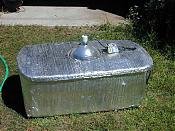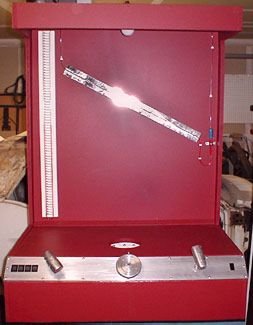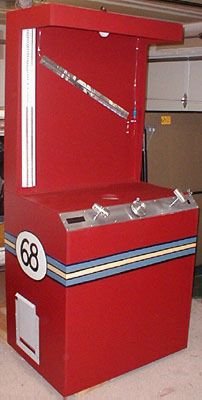cobrarwanab
Club Member
For a while now I have been thinking of this homemade flowbench idea for at home head porting. Here is a blueprint i made of it. The theory is listed below blueprint. Wondering What you guys think about it!

Here is the theory!
1. Get shop vac
2. Connect tube or pipe to suction port of a shop vac.
3. Using wood or plexi glass create 2 plates with a hole in the center.( Cut hole to the engine bore size the head will be installed on.)
4. Find a tube with a bore that matches your engine bore.
5. Sandwich bore tube between the 2 plates you made to create bore adapter.
6. Connect suction tube or hose to bore adapter.
7. 1/2 way between shop vac and bore adapter install vacuum gauge in-line with suction tube or hose.
8. Install Valves in head using cheep test springs that will over power the max vacuum pressure the shop vac can produce.
9. Using a square piece of card bord, cut a hole in the center of it the same size as the bore adapter.
10. Clamp head to bore adapter using cardboard as a "head gasket".
11. Clamp a dial indicator to the head with tip of indicator pushing on top of valve stem.
Now my theory is that with the head in stock condition, turn the shop vac on. using the dial indicator open the valve .100 and record the vacuum pressure the vac gague shows. Then open the valve .300 and record the data. Last, open the valve .500 and record the data.
Now port your head! Using the same valve opening steps you should get less vacuum pressure at the same amount of valve lift wright?
Example--
Before port job.
Valve open .100 = 4psi Vacuum
.300 = 3psi
.500 = 2psi
After port job
Valve open .100 = 3 1/2psi
.300 = 2 1/2psi
..500 = 1 1/2psi
Will it work?

Here is the theory!
1. Get shop vac
2. Connect tube or pipe to suction port of a shop vac.
3. Using wood or plexi glass create 2 plates with a hole in the center.( Cut hole to the engine bore size the head will be installed on.)
4. Find a tube with a bore that matches your engine bore.
5. Sandwich bore tube between the 2 plates you made to create bore adapter.
6. Connect suction tube or hose to bore adapter.
7. 1/2 way between shop vac and bore adapter install vacuum gauge in-line with suction tube or hose.
8. Install Valves in head using cheep test springs that will over power the max vacuum pressure the shop vac can produce.
9. Using a square piece of card bord, cut a hole in the center of it the same size as the bore adapter.
10. Clamp head to bore adapter using cardboard as a "head gasket".
11. Clamp a dial indicator to the head with tip of indicator pushing on top of valve stem.
Now my theory is that with the head in stock condition, turn the shop vac on. using the dial indicator open the valve .100 and record the vacuum pressure the vac gague shows. Then open the valve .300 and record the data. Last, open the valve .500 and record the data.
Now port your head! Using the same valve opening steps you should get less vacuum pressure at the same amount of valve lift wright?
Example--
Before port job.
Valve open .100 = 4psi Vacuum
.300 = 3psi
.500 = 2psi
After port job
Valve open .100 = 3 1/2psi
.300 = 2 1/2psi
..500 = 1 1/2psi
Will it work?



